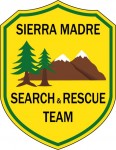During the month of June, Sierra Madre Search and Rescue (SMSR) responded to 11 calls for assistance, including six in a single weekend.
Missing Hikers, Monrovia Canyon Park: The Team was notified that the Monrovia Police Department was investigating a report of two hikers missing overnight in Monrovia Canyon Park. SMSR sent several search teams into the field and discovered the subjects’ footprints. Team members tracked the footprints to the subjects, who were in good condition.
Fall Victim, Sturtevant Falls: SMSR responded to a report of a fall victim at Sturtevant Falls near Chantry Flat. The patient was treated by paramedics from the Sierra Madre Fire Department and the L.A. County Fire Department in addition to EMT-certified SMSR personnel. The Team evacuated the patient via litter wheel-out to an ambulance at Chantry Flat.
Missing Hiker, Yosemite National Park: Yosemite National Park Search and Rescue requested the assistance of SMSR in the search for a missing hiker. SMSR team members departed Station 108 in the evening and drove through the night to be on hand for the following morning’s search. Team members were inserted by helicopter to search a remote section of the park and then airlifted out. The hiker has not yet been found.
In June, the latest class of SMSR probationary members completed their multi-day final field test and graduated to full member status, earning the right to wear the blue Mountain Rescue Association patch. Of nine prospective members who began the training last year, only four successfully completed the arduous process.
New member training for SMSR members lasts 18 months and represents a serious commitment of time and effort. Probationary members must attend a training class one night per week, two team trainings per month, and a monthly team meeting. After an initial six-month training period they are expected to participate in field operations as well. Outside of official Team activities, trainees spend much of their “free” time practicing and perfecting the skills they learn in class. Between scheduled trainings, operations, and practice, it is not uncommon for probationary members to devote 20 hours a week to the Team.
The time commitment is immense but necessary to learn what it takes to function as an SMSR team member, including high-angle rescue, land navigation, radio operations, man-tracking, patient packaging, snow and alpine travel, helicopter operations, and swiftwater rescue. All these skills must be performed in extremes of heat and cold, at any time of the day or night. As the team motto says: “Anywhere in the wilderness that someone needs help…”
After a short break, new team members begin the next phase of their training: three months of night school to earn their EMT certifications, a requirement for all Team members.
The commitment to joining the team is a financial one as well. Probationary members must purchase much of their personal equipment themselves, spending on average $1,000-2,000 dollars during their first year with the Team.
SMSR is currently recruiting for its next probationary members’ class. The only requirements for consideration are that candidates live within 20 minutes of Sierra Madre, be 25 to 55 years of age, and be physically fit and comfortable in the outdoors. And, of course, that they have a desire to work hard to help others. Visit the Team’s website for application information.
For 60 years the all-volunteer Sierra Madre Search and Rescue team has been responding to calls for help in the local mountains and beyond. Funded entirely by private donations, SMSR provides a range of public programs on wilderness safety in addition to its search and rescue activities. The Team never charges for any of its services.
For more information, including how to arrange a wilderness safety demonstration for your school or group, visit www.smsr.org.

